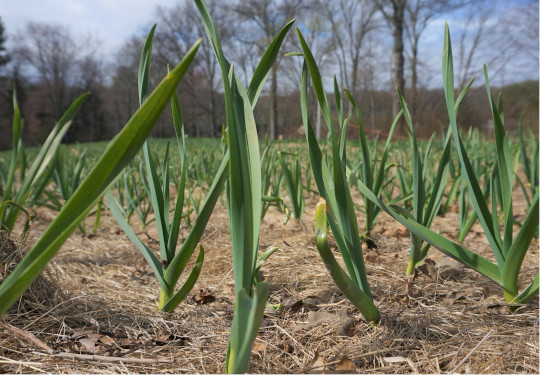Texas Certified Expert Gardener- Garlic growing guide: Planting to harvesting
Published 7:36 pm Monday, August 19, 2024

- Once leaves begin to appear in spring, it’s time to feed the plants with two teaspoons high-nitrogen fertilizer which slowly decomposes, such as blood meal which must be worked into the soil near the plant (Courtesy: Stonepierpress.org).
|
Getting your Trinity Audio player ready...
|
Hopefully, some readers were gifted with rainfall during the past week. This isn’t the case for most of us (me included) who are dragging garden hoses around the property daily to provide much needed water to flower gardens, trees, and vegetable beds. We limit the amount of water provided to the lawn using an irrigation system to evening hours. According to local meteorologists, rainfall probabilities are slightly improved from the previous weeks’ forecast, so let’s hold out hope for much needed rainfall.
Many of us cook with garlic, which is readily available in many forms such as garlic powder, flakes, granules, or already minced in a jar, which I refer to as “jar-lic.” Some cooks elect to use one or more of the many available options for convenience. This is not my preference, as I always choose flavor over convenience, especially when presented with “jar-lic” which to me has an unusual metallic flavor profile and is not reminiscent of real garlic.
This brings me to our topic today, which is how to grow garlic.
In case you didn’t know, garlic purchased at our local grocery markets have been in storage prior to being placed in the produce section. Cold storage confuses garlic’s internal clock which prolongs its shelf life and delays the aging process. The process of cold storing garlic does influence garlics taste … which is diminished depending on the storage interval. For this reason, gardeners should consider growing garlic, which is not a complicated process, and the taste of fresh garlic is astounding and includes many varieties with more intense flavor profiles than the limited selections available at our local markets.
There are three types of garlic: Softneck, Hardneck and Elephant.
Softneck garlic grows best in the south and other areas where winters are mild. Most varieties do not produce scapes which are thin, green curled stalks. Varieties include Creole, Silver Rose, Loiacono, Early Italian, and many others.
Hardneck types are adapted to cold winter areas, and all produce curled scapes in early summer. A few popular varieties include Porcelain, Purple stripe, Montana Giant and Shilla.
Elephant (is a type of leek and is not a garlic variety) garlic produces a large, mild-flavored bulb comprised of four to six big cloves.
For gardeners in our area of SETX garlic is best planted in late fall or early winter. Garlic can be planted in the spring, but yields will be much lower.
For now, let’s focus on fall planting where the roots develop during the cooler winter months and then in early spring leaf growth will begin to appear, which is necessary for large bulbs to form.
Plant garlic in a raised bed or an area not recently used for garlic or other plants in the allium family. Amend the soil with seasoned compost (composted manure) into the top 6 inches of soil along with 10-10-10 fertilizer. Turn the soil until it is crumbly, loose and well drained.
Separate the garlic bulbs into individual cloves, plant each clove (pointed end up) 4 inches apart, then cover with 1 to 2 inches of soil. Cover garlic bed with 4 inches of mulch or pine straw to protect garlic during winter low temps.
Once leaves begin to appear in spring, it’s time to feed the plants with two teaspoons high-nitrogen fertilizer, which slowly decomposes, such as blood meal which must be worked into the soil near the plant. Add mulch as needed.
Garlics growth stages
GREEN GARLIC (leaves) is simply young garlic, which looks like leeks and green onion but with a sweeter, more mellow flavor than a garlic clove. As the leaf continues to grow, the bottom begins to round slowly becoming a bulb. Pick stalks that are fully green and fresh, not wilted. Yellow leaves are a signal the plant is close to becoming a bulb.
GARLIC SCAPES are formed after the green garlic has formed the bulbous bottom but before the bulb is ready for harvest. The bulb sends out a long, thin, curly stalk from its center called the scape. Scapes only grow on
Hardneck varieties and like green garlic they are tender and fully usable. They normally last the first few weeks of June.
GARLIC BULBS should be ready to harvest near July 4. They should be full and covered with their papery skins and ready to dig. They will be juicy and full of moisture at this point, as they have not cured. Make sure the bulbs are firm to the touch and heavy for their size. Some clusters may be more open than others, which make clove separation easier.
BLACK GARLIC is a regular head of garlic, which is caramelized by heat and humidity in a week-long fermentation process. The result is sweet, soft, and as you probably guessed, black cloves. It is easy to make with recipes readily available by web search.
Garlic is ready to harvest when the leaves begin to turn brown. Begin checking when there are 5 to 6 leaves left.
Garlic must be cured before attempting to store it. Bundle 10 to 14 plants together using their leaves and hang them to dry. Garlic needs to be cured for two weeks or until stalks have completely turned brown. Remove garlic bulbs from leaves and store inside.
Storing garlic
Green Garlic – up to two weeks in loose plastic or mesh bags in crisper drawer so air can circulate.
Freshly harvested bulbs – up to 2 months in pantry or dry spot, out of direct sunlight.
Supermarket garlic – up to 1 month (on the counter) before green sprouts begin forming.
Black Garlic – Store in refrigerator.
Do not refrigerate garlic bulbs. Dry, room temperature is perfect out of direct sunlight.
GARLIC VARIETIES
California White – a last resort if there are no other options. Grocery markets typically sell this variety, not as flavorful as varieties.
Italian Purple – some people like to eat raw (not me) but has a slight spiciness if used raw.
Music – robust, mellow, sweet, and delicious used raw in salt roasted dressing, or garlic toast.
Russian Red – this variety is very pungent, and powerful. Excellent roasted or when a recipe focuses on garlic.
German Extra Hardy – this garlic variety is by far my absolute favorite. The cloves are extremely large, and easy to separate. The garlic smell is wonderful and enticing. Excellent sautéed in all your favorite dishes.
German White– this is another favorite garlic variety which is very easy to peel. The variety is pungent but not excessively so.
Georgia Fire– is too hot (spicy) to be eaten raw. This variety is best used in dishes which require a powerful punch with a bit of heat!
John Greene is a Texas Certified Expert Gardener. Contact him at jongreene57@gmail.com.





